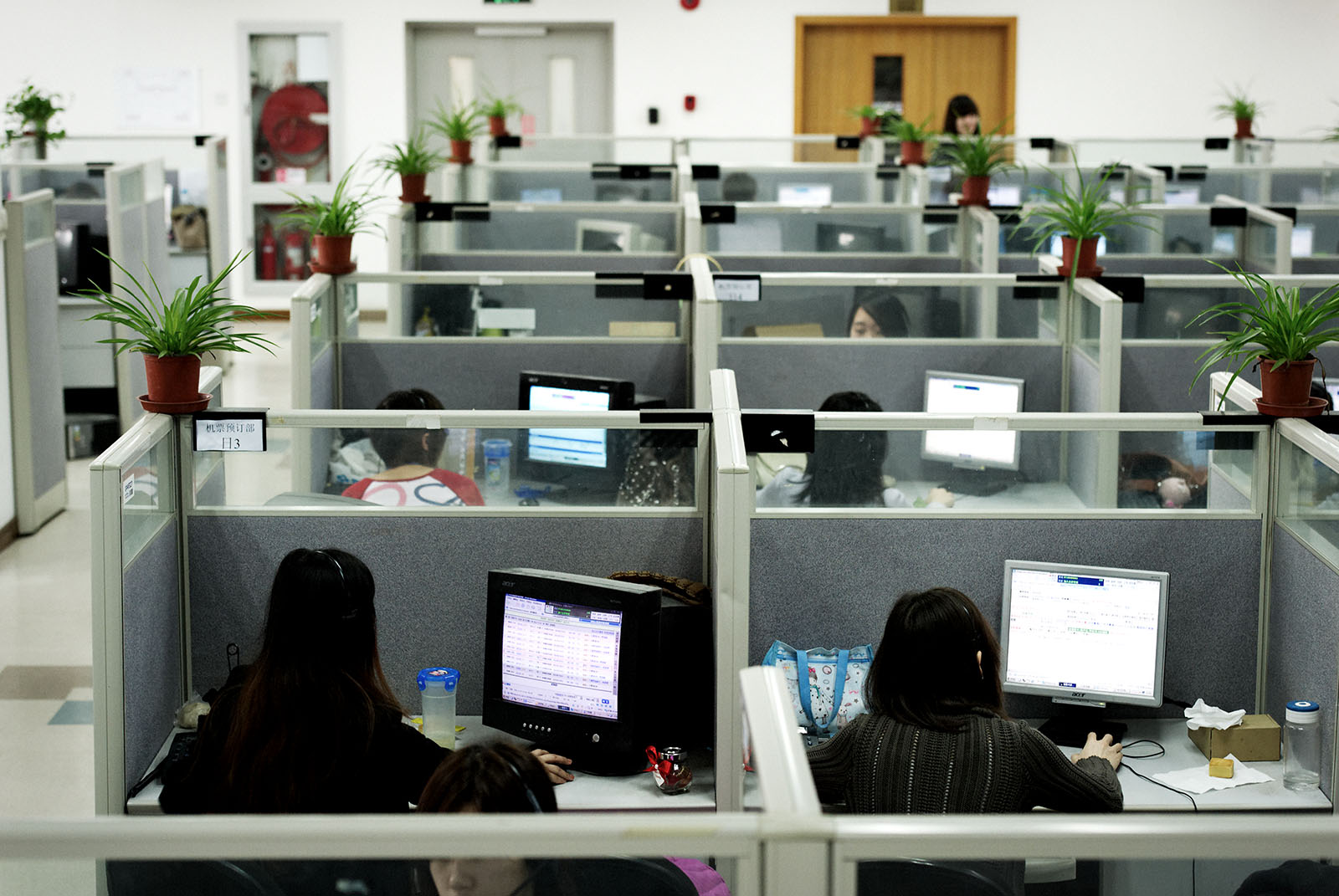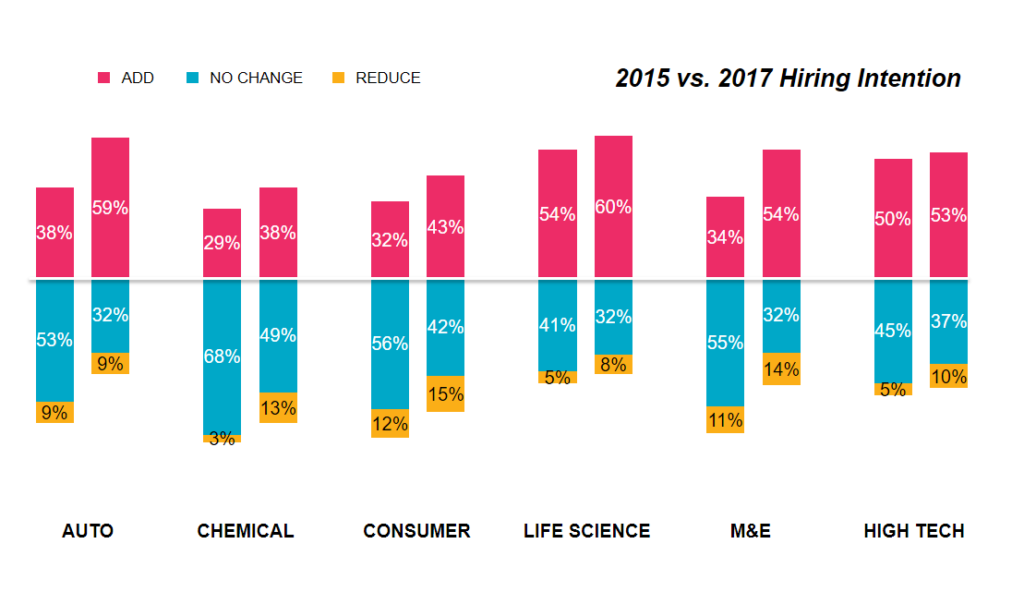Navigating HR Challenges in China

Employees work on the floor of an office in Shanghai. Chinese workers are increasingly seeking a fair and competitive compensation package.
Photo: Andrew Ross/AFP/Getty Images
An increase in global growth was projected at the 2017 World Economic Outlook. Aggregate global output was estimated to grow by 3.5 percent in 2017 and 3.6 percent in 2018. Economic growth in China, meanwhile, has remained steady between 6.7 to 6.9 percent for eight consecutive quarters, signaling stable economic growth. In the recent past, changes in China include discontinuing its one child policy and higher outbound investments, plus it is expected that technology will comprise a sizeable share of its exports.
Currently, China’s primary sectors include automotive, chemicals, life sciences, consumer goods, media and entertainment and technology. While China is a manufacturing powerhouse, an interesting trend is that the service sector plays a major role in Tier 1 cities across the country. For example, in Shanghai, the service sector contributes to 69.8 percent of total GDP. Hiring by Chinese companies has been steady, with five of its primary sectors recording higher figures for 2017. Reputed higher education institutions ensure adequate supply of talent, but there are distinct shifts in what employees entering the workforce currently value.
Intention to Hire on the Rise Across Industries
Shift in What Chinese Employees Value
Chinese workers are increasingly seeking a fair and competitive compensation package. Upward mobility is also a top priority. Workers also seek recognition for their achievements, and 96 percent want to be recognized and rewarded for a wider range of contributions. In this regard, performance management is one way of ensuring top contributors are acknowledged for their efforts. Employees in China are expecting their employers to “make work, work.” Key areas that they would like their organizations to focus on include:
Health Care: An estimated 62 percent want their companies to pay heed to their health and wellness.
Career Progression: Twenty-one percent feel they are not empowered to steer their careers and succeed.
Flexibility: More than 50 percent desire flexible work hours.
According to Mercer’s Global Talent Trends Study 2017 (China), executives, human resource leaders and employees feel organizations must:
- Simplify decision-making
- Pay fair compensation packages
- Help employees invest in themselves
- Understand their unique skills and interests
What Does the Current Generation Value?
The first choice for graduates in China is seeking employment in a privately owned enterprise. More than 50 percent choose this avenue and the trend of taking a “gap year” is gaining in popularity. Many opt to study further, while an estimated 15 percent decide to go the entrepreneurial route.
Most seem to hold high expectations of their jobs and the result is usually low job satisfaction.
Loyalty towards one organization is poor: 34 percent of surveyed employers believe young employees have a poor sense of responsibility. Almost 47 percent of surveyed employers also reported that young employees were unable to handle stressful jobs. Employees are now emphasizing personal values over organizational ones, wherein the organization can help them invest in themselves. Most Chinese companies see future process to be driven by talent, technology, industry upgrades, prioritizing high quality and environmentally conscious development.
Skilled technical personnel are sought after and popular vacant positions include those of R&D manager, application engineering manager, process engineering manager, senior hardware development engineer and software development engineer.
Addressing Human Resource Challenges
In order to further career development, employers must offer training, leadership and growth prospects. This could be in the form of encouraging startups within companies, providing fast-track programs with specialized trainings, communicating promptly in a manner that is both transparent and efficient and enhancing flexibility in working time, location and benefits.
Some of the more innovative suggestions include co-investment and “amoeba management.” The latter is a form of management that was devised at electronics company Kyocera. It involves establishing small units, each with a leader. Goals are achieved by the combined efforts of the unit members, with the underlying idea being to ensure “management by all.”
Furthermore, it is imperative for companies to attract and retain top talent. Career paths must be outlined clearly, candidates must be engaged as customers and companies could consider hiring nontraditional talent. Change is rapid and organizations must brace themselves for the unforeseen. They must:
- Reduce risk by building a diverse portfolio of skills and a culture of innovation
- Quantify future-focused capability gaps through integrated people planning
- Simplify decision making and enhance accessibility to knowledge and experts
- Accelerate progress through experiences and continual learning
A thriving workforce is an asset to any organization. Considering the tendency of current workers to switch jobs multiple times, companies could work towards creating a sense of loyalty, identifying talent choke points and promoting a contribution culture.
Gearing Up For the Future
Traditionally, companies in China have offered various perquisites to their workers. Currently, though, perks must be offered in more innovative packages. Options such as a transportation or skill allowance could evolve into holiday bonuses for top performers. Medical insurance, a company car or supplementary retirement benefits can now be awarded in the form of child care facilities, cashless medical care and parent-support insurance. For companies to stay relevant and ensure their ability to meet worker’s expectations, they must consider:
- Enhancing core values with technology
- Building the organization’s capability to support and withstand business change
- Engaging talents and encouraging entrepreneurship
In addition, organizations must listen and learn. The ability to derive actionable insights from talent data is a fundamental part of the empowerment agenda.
This is the fourth and final part of a series on “Navigating HR Challenges in Asia.” Read the first part here, the second part here and the third part here.






